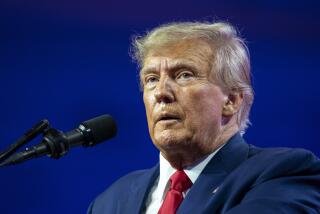Treasury’s 30-Year Bonds to Reemerge
Four years ago, the federal government was running such big budget surpluses that it quit selling 30-year Treasury bonds, its longest-term securities. It was seen as a step toward the day when Uncle Sam would be totally debt-free.
On Wednesday, the Treasury Department announced it would resume selling those bonds in February. It was an unmistakable symbol that the era of red ink has returned.
The Treasury announcement was met with almost universal approval: Treasury officials said the move would diversify their arsenal of money-raising instruments. Bond dealers welcomed a new security they could sell. For pension funds and other big investors, and for baby boomers on the brink of retirement, the 30-year bond will offer a way to lock in a guaranteed income stream over a long period.
Although the Treasury did not say so, 30-year bonds also could save the government billions of dollars in interest costs by locking in today’s low long-term rates through 2036.
“Implicitly, there is a potential that interest rates will move higher,” said Jack Malvey, chief global fixed-income strategist for Lehman Bros. in New York.
The longest Treasury securities now on the market, which come due in 2031, carry historically low rates of about 4.5%. That is scarcely more than the 4.3% available on 10-year Treasuries (the longest maturity that has been sold since 2001), or even the 4% on securities that come due in two years.
Timothy S. Bitsberger, assistant Treasury secretary for financial markets, said the department expected to sell $20 billion to $30 billion a year in 30-year bonds in semiannual sales in February and August.
The Bond Market Assn., which has been working to reinstate the 30-year bond since sales ended in 2001, applauded the move as good news for the government and for investors.
Resumption of the long bond “is likely to provide Treasury with greater flexibility in managing its debt portfolio and make it better able to lower its borrowing costs in the long term, thus saving money for U.S. taxpayers,” Micah Green, president of the association, said in a statement.
Analysts say Wall Street also is eager to see the return of the 30-year bond in part because the issue will provide another product for brokers to sell.
“The market is happy to have more securities to trade,” said David MacEwen, chief investment officer for fixed income at American Century Investments in Mountain View, Calif.
Pension funds in particular are expected to have a strong appetite for the bonds because they allow the funds to lock in a set return for three decades. That can help them better plan for long-term commitments to retirees.
Because U.S. pension funds and other domestic investors are expected to be primary buyers of 30-year bonds, analysts say the government will gain some protection against the possibility that foreign investors -- who now own 53% of marketable Treasury issues -- might shy away from buying more, potentially driving up interest rates.
“If there were a dramatic shift in foreigners’ appetite [for U.S. bonds], this is one outlet the government has created for itself,” said Steve Rodosky, head of the Treasury desk at Newport Beach-based Pacific Investment Management Co., a major bond-investment firm.
The U.S. enjoyed a record budget surplus of $236.9 billion in 2000 and ran another surplus in 2001. But the deficit returned in 2002, and swelled to a record $412.5 billion last year. The national debt is now $7.8 trillion.
Some analysts say it was a mistake for the government to stop borrowing via 30-year bonds in the first place, given the sharp slide in long-term interest rates since 2000.
“Up until now, everyone in America got to refinance their debt at ultra-low rates -- except Uncle Sam,” said Barry Ritholtz, market strategist at brokerage Maxim Group in New York.
“We’re not in the business of trying to time interest rates,” the Treasury’s Bitsberger said. “It was the right decision in 2001 to get rid of [the bond], and it is the right decision now to bring it back.”
Havemann reported from Washington and Petruno from Los Angeles.






